engine FORD F750 2004 11.G Service Manual
[x] Cancel search | Manufacturer: FORD, Model Year: 2004, Model line: F750, Model: FORD F750 2004 11.GPages: 264, PDF Size: 1.47 MB
Page 119 of 264
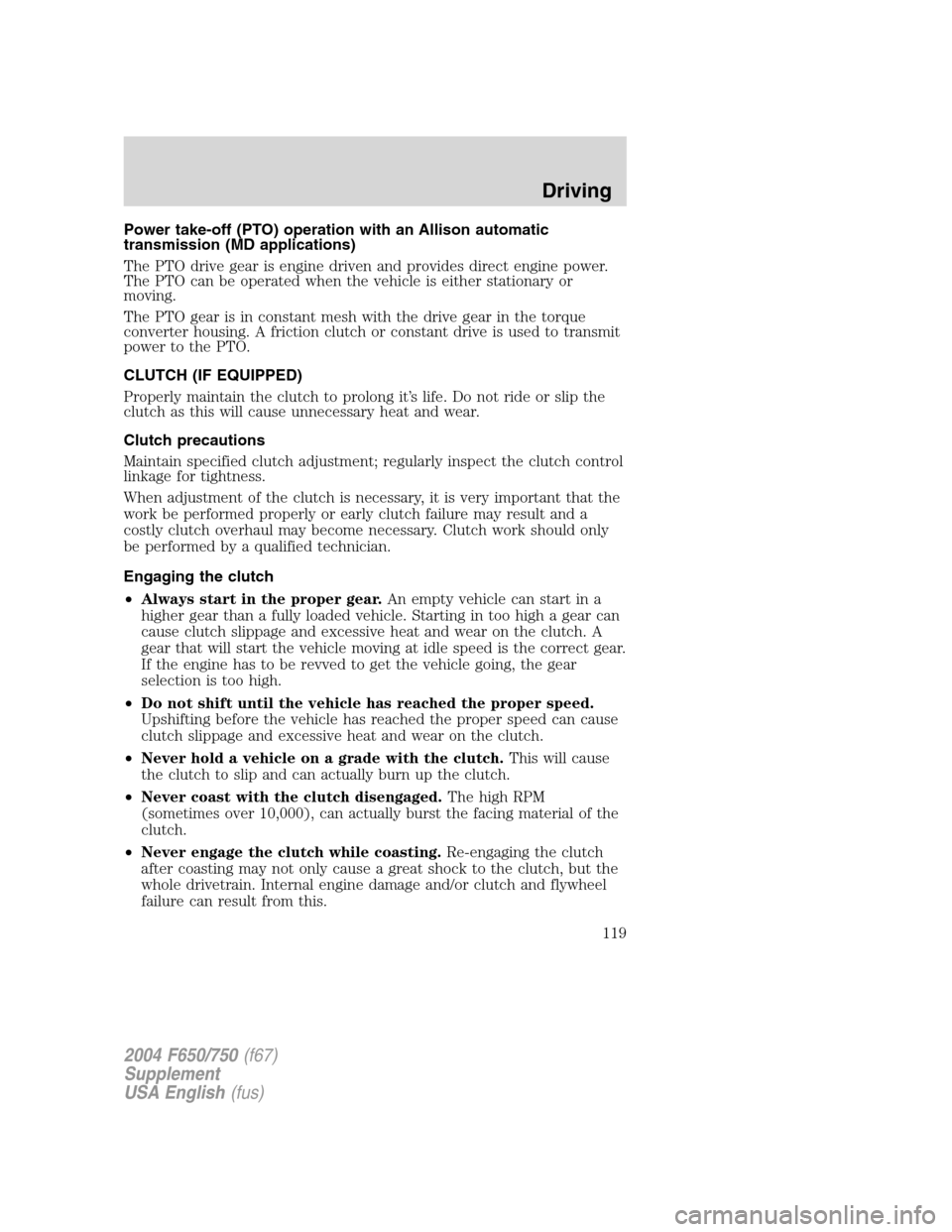
Power take-off (PTO) operation with an Allison automatic
transmission (MD applications)
The PTO drive gear is engine driven and provides direct engine power.
The PTO can be operated when the vehicle is either stationary or
moving.
The PTO gear is in constant mesh with the drive gear in the torque
converter housing. A friction clutch or constant drive is used to transmit
power to the PTO.
CLUTCH (IF EQUIPPED)
Properly maintain the clutch to prolong it’s life. Do not ride or slip the
clutch as this will cause unnecessary heat and wear.
Clutch precautions
Maintain specified clutch adjustment; regularly inspect the clutch control
linkage for tightness.
When adjustment of the clutch is necessary, it is very important that the
work be performed properly or early clutch failure may result and a
costly clutch overhaul may become necessary. Clutch work should only
be performed by a qualified technician.
Engaging the clutch
•Always start in the proper gear.An empty vehicle can start in a
higher gear than a fully loaded vehicle. Starting in too high a gear can
cause clutch slippage and excessive heat and wear on the clutch. A
gear that will start the vehicle moving at idle speed is the correct gear.
If the engine has to be revved to get the vehicle going, the gear
selection is too high.
•Do not shift until the vehicle has reached the proper speed.
Upshifting before the vehicle has reached the proper speed can cause
clutch slippage and excessive heat and wear on the clutch.
•Never hold a vehicle on a grade with the clutch.This will cause
the clutch to slip and can actually burn up the clutch.
•Never coast with the clutch disengaged.The high RPM
(sometimes over 10,000), can actually burst the facing material of the
clutch.
•Never engage the clutch while coasting.Re-engaging the clutch
after coasting may not only cause a great shock to the clutch, but the
whole drivetrain. Internal engine damage and/or clutch and flywheel
failure can result from this.
2004 F650/750(f67)
Supplement
USA English(fus)
Driving
119
Page 120 of 264
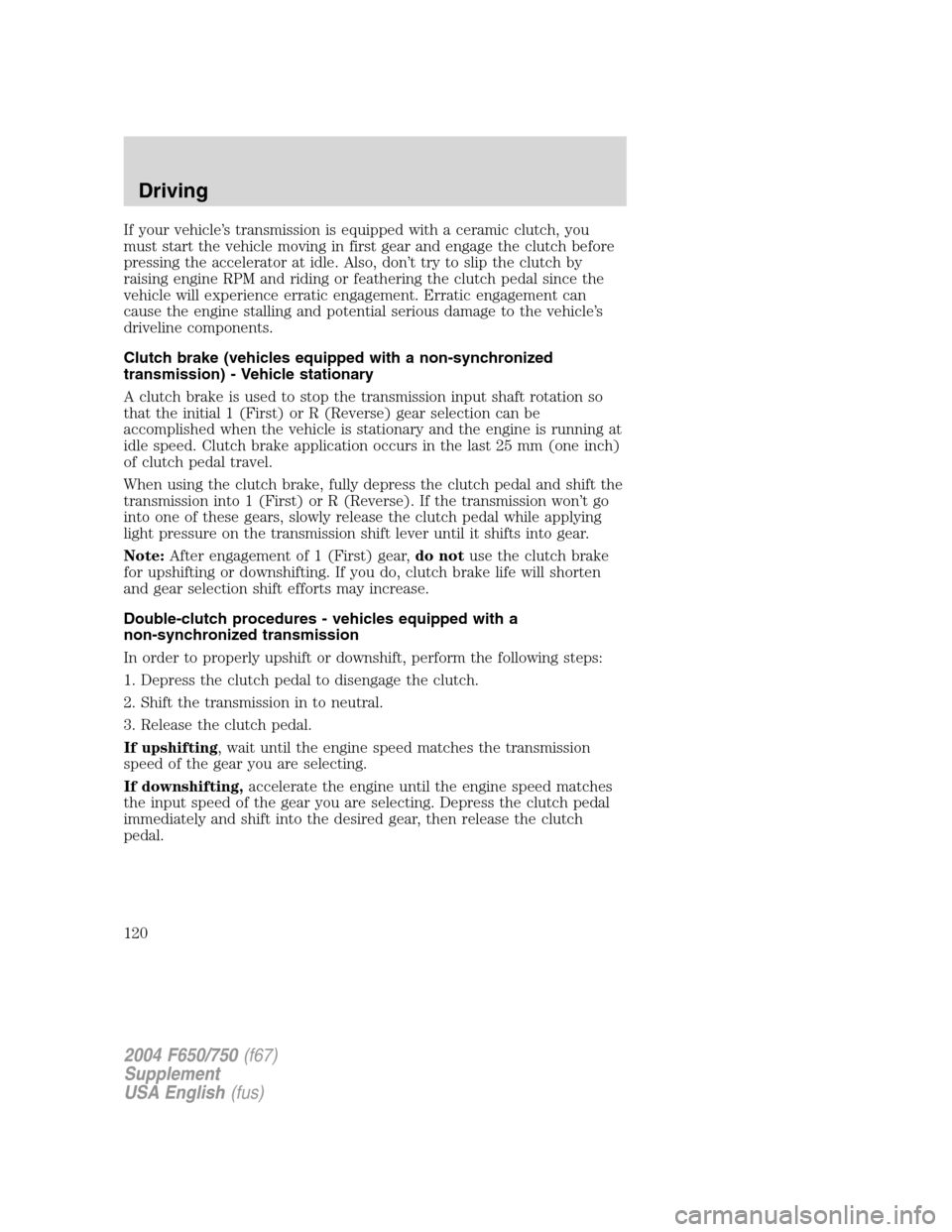
If your vehicle’s transmission is equipped with a ceramic clutch, you
must start the vehicle moving in first gear and engage the clutch before
pressing the accelerator at idle. Also, don’t try to slip the clutch by
raising engine RPM and riding or feathering the clutch pedal since the
vehicle will experience erratic engagement. Erratic engagement can
cause the engine stalling and potential serious damage to the vehicle’s
driveline components.
Clutch brake (vehicles equipped with a non-synchronized
transmission) - Vehicle stationary
A clutch brake is used to stop the transmission input shaft rotation so
that the initial 1 (First) or R (Reverse) gear selection can be
accomplished when the vehicle is stationary and the engine is running at
idle speed. Clutch brake application occurs in the last 25 mm (one inch)
of clutch pedal travel.
When using the clutch brake, fully depress the clutch pedal and shift the
transmission into 1 (First) or R (Reverse). If the transmission won’tgo
into one of these gears, slowly release the clutch pedal while applying
light pressure on the transmission shift lever until it shifts into gear.
Note:After engagement of 1 (First) gear,do notuse the clutch brake
for upshifting or downshifting. If you do, clutch brake life will shorten
and gear selection shift efforts may increase.
Double-clutch procedures - vehicles equipped with a
non-synchronized transmission
In order to properly upshift or downshift, perform the following steps:
1. Depress the clutch pedal to disengage the clutch.
2. Shift the transmission in to neutral.
3. Release the clutch pedal.
If upshifting, wait until the engine speed matches the transmission
speed of the gear you are selecting.
If downshifting,accelerate the engine until the engine speed matches
the input speed of the gear you are selecting. Depress the clutch pedal
immediately and shift into the desired gear, then release the clutch
pedal.
2004 F650/750(f67)
Supplement
USA English(fus)
Driving
120
Page 121 of 264
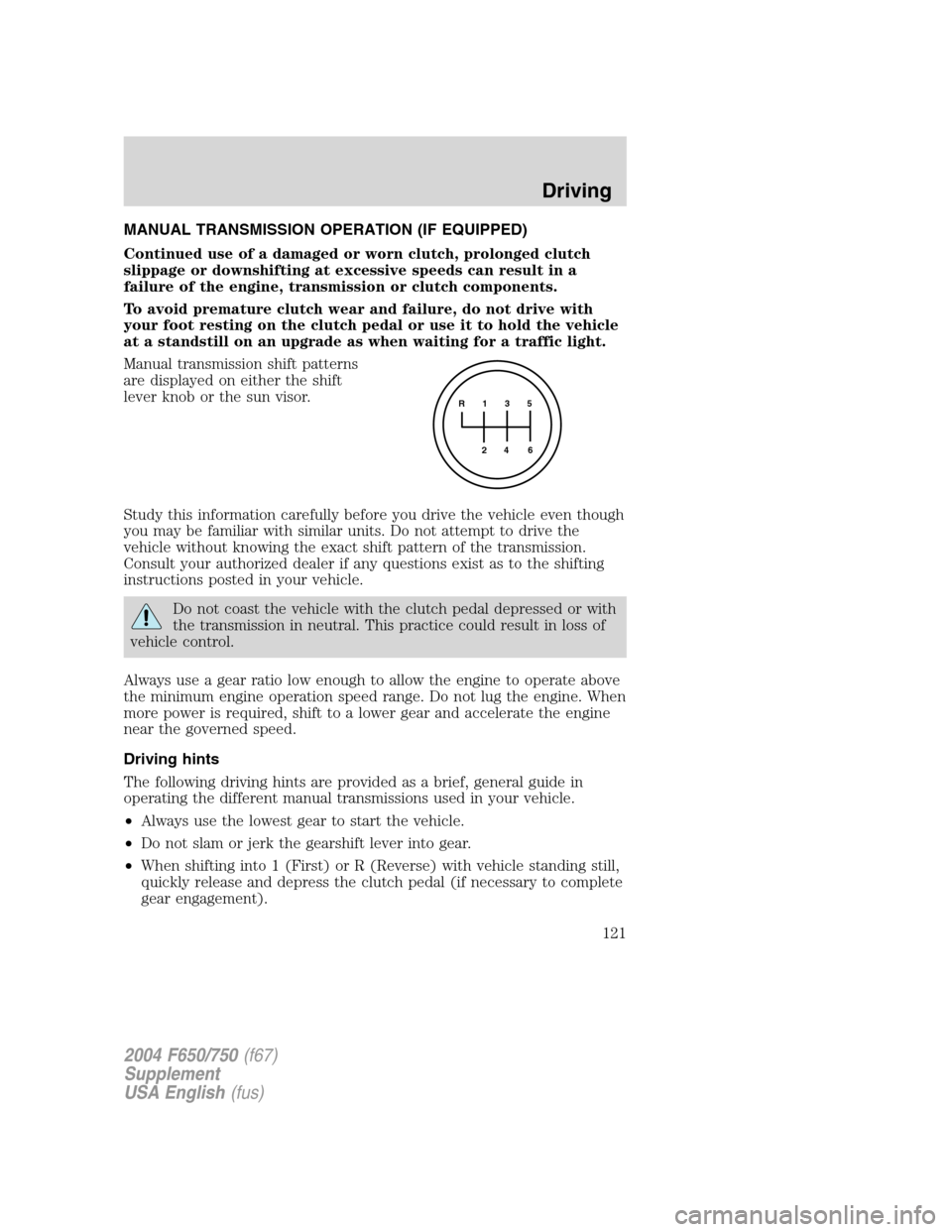
MANUAL TRANSMISSION OPERATION (IF EQUIPPED)
Continued use of a damaged or worn clutch, prolonged clutch
slippage or downshifting at excessive speeds can result in a
failure of the engine, transmission or clutch components.
To avoid premature clutch wear and failure, do not drive with
your foot resting on the clutch pedal or use it to hold the vehicle
at a standstill on an upgrade as when waiting for a traffic light.
Manual transmission shift patterns
are displayed on either the shift
lever knob or the sun visor.
Study this information carefully before you drive the vehicle even though
you may be familiar with similar units. Do not attempt to drive the
vehicle without knowing the exact shift pattern of the transmission.
Consult your authorized dealer if any questions exist as to the shifting
instructions posted in your vehicle.
Do not coast the vehicle with the clutch pedal depressed or with
the transmission in neutral. This practice could result in loss of
vehicle control.
Always use a gear ratio low enough to allow the engine to operate above
the minimum engine operation speed range. Do not lug the engine. When
more power is required, shift to a lower gear and accelerate the engine
near the governed speed.
Driving hints
The following driving hints are provided as a brief, general guide in
operating the different manual transmissions used in your vehicle.
•Always use the lowest gear to start the vehicle.
•Do not slam or jerk the gearshift lever into gear.
•When shifting into 1 (First) or R (Reverse) with vehicle standing still,
quickly release and depress the clutch pedal (if necessary to complete
gear engagement).
R 1 3 5
4
6 2
2004 F650/750(f67)
Supplement
USA English(fus)
Driving
121
Page 122 of 264
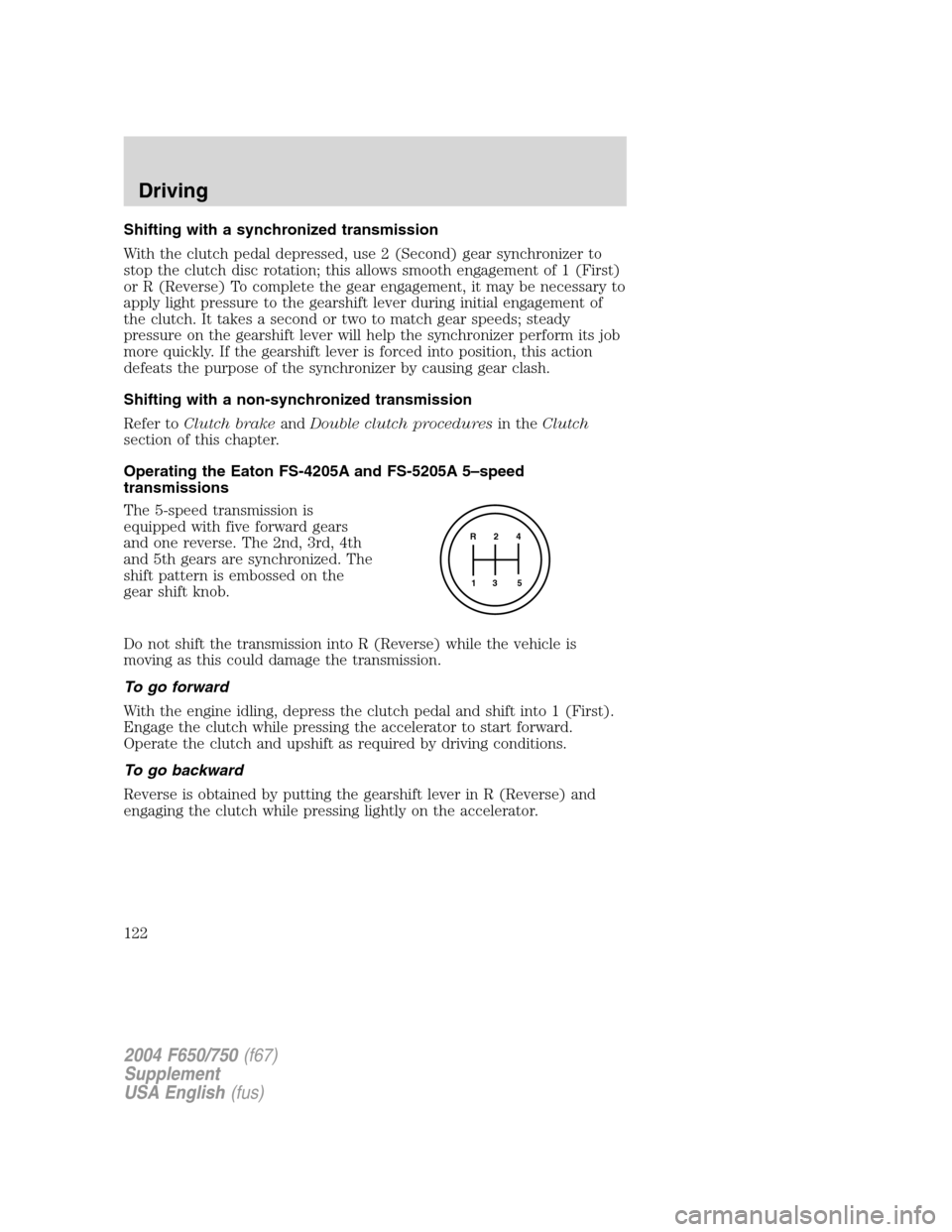
Shifting with a synchronized transmission
With the clutch pedal depressed, use 2 (Second) gear synchronizer to
stop the clutch disc rotation; this allows smooth engagement of 1 (First)
or R (Reverse) To complete the gear engagement, it may be necessary to
apply light pressure to the gearshift lever during initial engagement of
the clutch. It takes a second or two to match gear speeds; steady
pressure on the gearshift lever will help the synchronizer perform its job
more quickly. If the gearshift lever is forced into position, this action
defeats the purpose of the synchronizer by causing gear clash.
Shifting with a non-synchronized transmission
Refer toClutch brakeandDouble clutch proceduresin theClutch
section of this chapter.
Operating the Eaton FS-4205A and FS-5205A 5–speed
transmissions
The 5-speed transmission is
equipped with five forward gears
and one reverse. The 2nd, 3rd, 4th
and 5th gears are synchronized. The
shift pattern is embossed on the
gear shift knob.
Do not shift the transmission into R (Reverse) while the vehicle is
moving as this could damage the transmission.
To go forward
With the engine idling, depress the clutch pedal and shift into 1 (First).
Engage the clutch while pressing the accelerator to start forward.
Operate the clutch and upshift as required by driving conditions.
To go backward
Reverse is obtained by putting the gearshift lever in R (Reverse) and
engaging the clutch while pressing lightly on the accelerator.
R 2 4
3 5 1
2004 F650/750(f67)
Supplement
USA English(fus)
Driving
122
Page 123 of 264
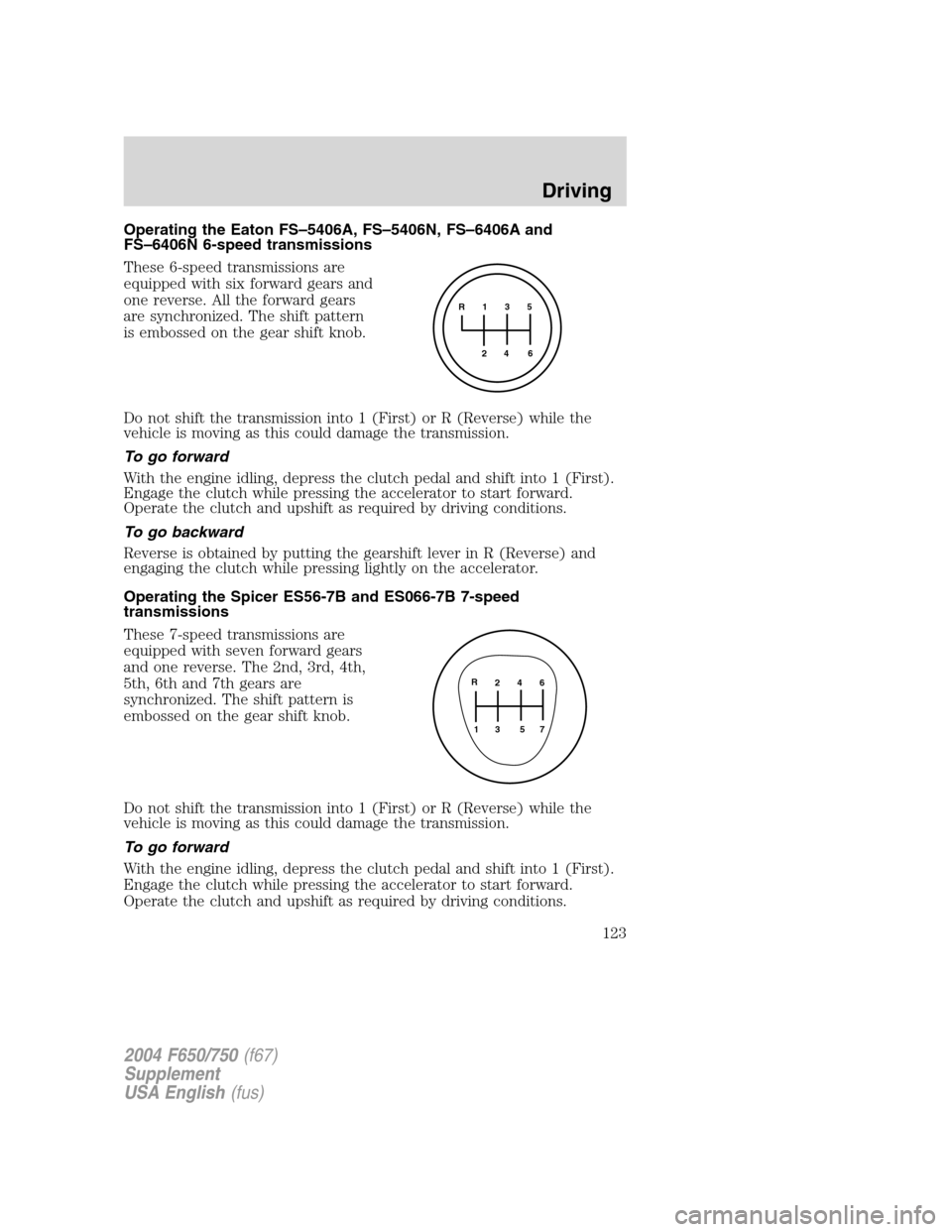
Operating the Eaton FS–5406A, FS–5406N, FS–6406A and
FS–6406N 6-speed transmissions
These 6-speed transmissions are
equipped with six forward gears and
one reverse. All the forward gears
are synchronized. The shift pattern
is embossed on the gear shift knob.
Do not shift the transmission into 1 (First) or R (Reverse) while the
vehicle is moving as this could damage the transmission.
To go forward
With the engine idling, depress the clutch pedal and shift into 1 (First).
Engage the clutch while pressing the accelerator to start forward.
Operate the clutch and upshift as required by driving conditions.
To go backward
Reverse is obtained by putting the gearshift lever in R (Reverse) and
engaging the clutch while pressing lightly on the accelerator.
Operating the Spicer ES56-7B and ES066-7B 7-speed
transmissions
These 7-speed transmissions are
equipped with seven forward gears
and one reverse. The 2nd, 3rd, 4th,
5th, 6th and 7th gears are
synchronized. The shift pattern is
embossed on the gear shift knob.
Do not shift the transmission into 1 (First) or R (Reverse) while the
vehicle is moving as this could damage the transmission.
To go forward
With the engine idling, depress the clutch pedal and shift into 1 (First).
Engage the clutch while pressing the accelerator to start forward.
Operate the clutch and upshift as required by driving conditions.
R 1 3 5
4
6 2
2 4 6
3 5 71 R
2004 F650/750(f67)
Supplement
USA English(fus)
Driving
123
Page 124 of 264

To go backward
Reverse is obtained by putting the gearshift lever in R (Reverse) and
engaging the clutch while pressing lightly on the accelerator.
Operating the Eaton 8908LL 10-speed transmission
These transmissions have five
forward speeds in the LO range, and
four forward speeds in the HI range.
These transmissions employ a Deep
Reduction Valve and control to allow
for a LO-LO gear operation for
adverse conditions. Study the
instruction plate on the sun visor
thoroughly and learn the shift
pattern of your transmission.
To go forward
With the engine idling, depress the clutch pedal and move the gearshift
lever to the neutral position.
Place the range selector in the LO
range and the Deep Reduction
Button in the OUT/REARWARD
position or,
place the Deep Reduction in the
IN/FORWARD position if you want
to start in LO-LO under adverse
conditions.
27
3
6
2 LO
LO-LO
8
4
R R
R R
5 1
1
Neutral
5
17
3
6
2 LO
LO-LO
8
4
R R
R
Neutral
5
17
3
6
2 LO
LO-LO
8
4
R R
R
Neutral
2004 F650/750(f67)
Supplement
USA English(fus)
Driving
124
Page 126 of 264

Operating the Eaton 9210B 10–speed transmissions
These transmission have five
forward speeds in both the LO and
HI ranges, and two reverse speeds.
Study the instruction plate on the
sun visor and learn the shift pattern
of your transmission.
To go forward
With the engine idling, depress the
clutch pedal and push the range
control button to the LO range
position. Shift into the LO gear
position and engage the clutch while
pressing on the accelerator to start
forward. Operate the clutch and
upshift through the pattern as
required by driving conditions. To
shift into the HI range from 5th gear
(LO range), place the range control
in the HI range position, then shift into 6th gear. When downshifting
from HI to LO, place the range control into the LO range, then downshift
from 6th gear to 5th gear (below 1,500 engine RPM).
To go backward
Reverse is obtained by putting the
gearshift lever in R (Reverse) and
the range control button in LO or
HI.
7
29
4
8
3 6
1
10
5
R
Neutral
7
29
4
8
3 6
1
10
5
R
Neutral
2004 F650/750(f67)
Supplement
USA English(fus)
Driving
126
Page 128 of 264
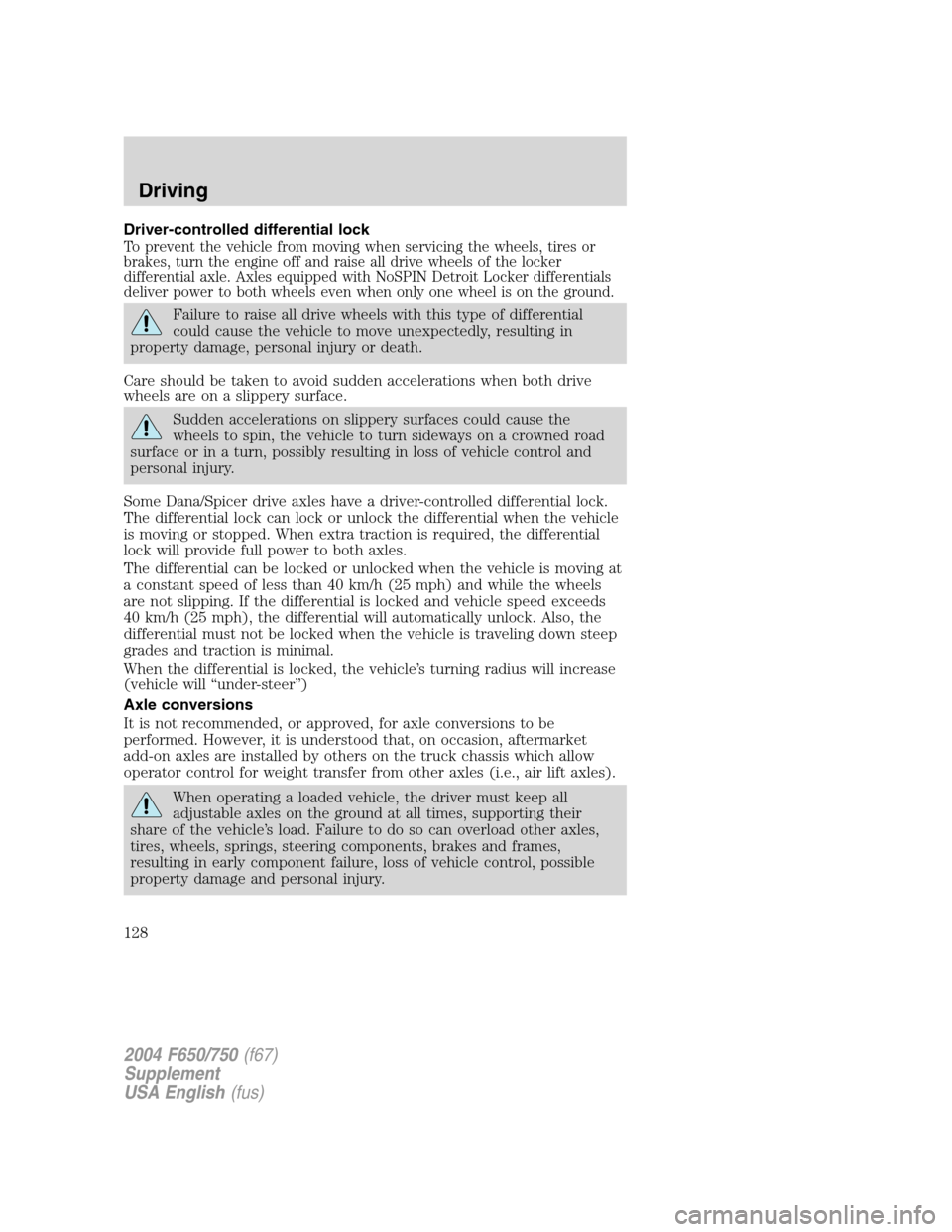
Driver-controlled differential lock
To prevent the vehicle from moving when servicing the wheels, tires or
brakes, turn the engine off and raise all drive wheels of the locker
differential axle. Axles equipped with NoSPIN Detroit Locker differentials
deliver power to both wheels even when only one wheel is on the ground.
Failure to raise all drive wheels with this type of differential
could cause the vehicle to move unexpectedly, resulting in
property damage, personal injury or death.
Care should be taken to avoid sudden accelerations when both drive
wheels are on a slippery surface.
Sudden accelerations on slippery surfaces could cause the
wheels to spin, the vehicle to turn sideways on a crowned road
surface or in a turn, possibly resulting in loss of vehicle control and
personal injury.
Some Dana/Spicer drive axles have a driver-controlled differential lock.
The differential lock can lock or unlock the differential when the vehicle
is moving or stopped. When extra traction is required, the differential
lock will provide full power to both axles.
The differential can be locked or unlocked when the vehicle is moving at
a constant speed of less than 40 km/h (25 mph) and while the wheels
are not slipping. If the differential is locked and vehicle speed exceeds
40 km/h (25 mph), the differential will automatically unlock. Also, the
differential must not be locked when the vehicle is traveling down steep
grades and traction is minimal.
When the differential is locked, the vehicle’s turning radius will increase
(vehicle will“under-steer”)
Axle conversions
It is not recommended, or approved, for axle conversions to be
performed. However, it is understood that, on occasion, aftermarket
add-on axles are installed by others on the truck chassis which allow
operator control for weight transfer from other axles (i.e., air lift axles).
When operating a loaded vehicle, the driver must keep all
adjustable axles on the ground at all times, supporting their
share of the vehicle’s load. Failure to do so can overload other axles,
tires, wheels, springs, steering components, brakes and frames,
resulting in early component failure, loss of vehicle control, possible
property damage and personal injury.
2004 F650/750(f67)
Supplement
USA English(fus)
Driving
128
Page 132 of 264
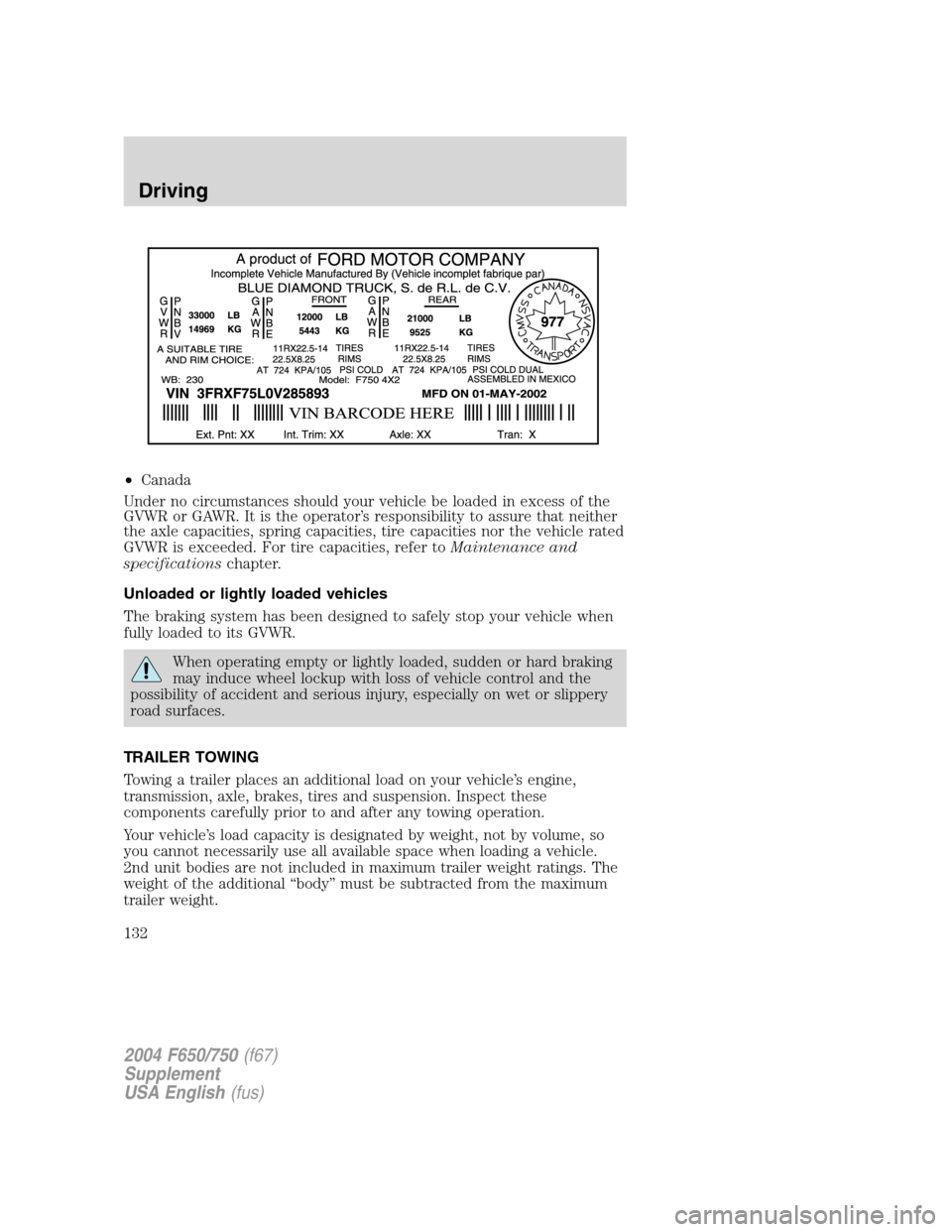
•Canada
Under no circumstances should your vehicle be loaded in excess of the
GVWR or GAWR. It is the operator’s responsibility to assure that neither
the axle capacities, spring capacities, tire capacities nor the vehicle rated
GVWR is exceeded. For tire capacities, refer toMaintenance and
specificationschapter.
Unloaded or lightly loaded vehicles
The braking system has been designed to safely stop your vehicle when
fully loaded to its GVWR.
When operating empty or lightly loaded, sudden or hard braking
may induce wheel lockup with loss of vehicle control and the
possibility of accident and serious injury, especially on wet or slippery
road surfaces.
TRAILER TOWING
Towing a trailer places an additional load on your vehicle’s engine,
transmission, axle, brakes, tires and suspension. Inspect these
components carefully prior to and after any towing operation.
Your vehicle’s load capacity is designated by weight, not by volume, so
you cannot necessarily use all available space when loading a vehicle.
2nd unit bodies are not included in maximum trailer weight ratings. The
weight of the additional“body”must be subtracted from the maximum
trailer weight.
2004 F650/750(f67)
Supplement
USA English(fus)
Driving
132
Page 133 of 264
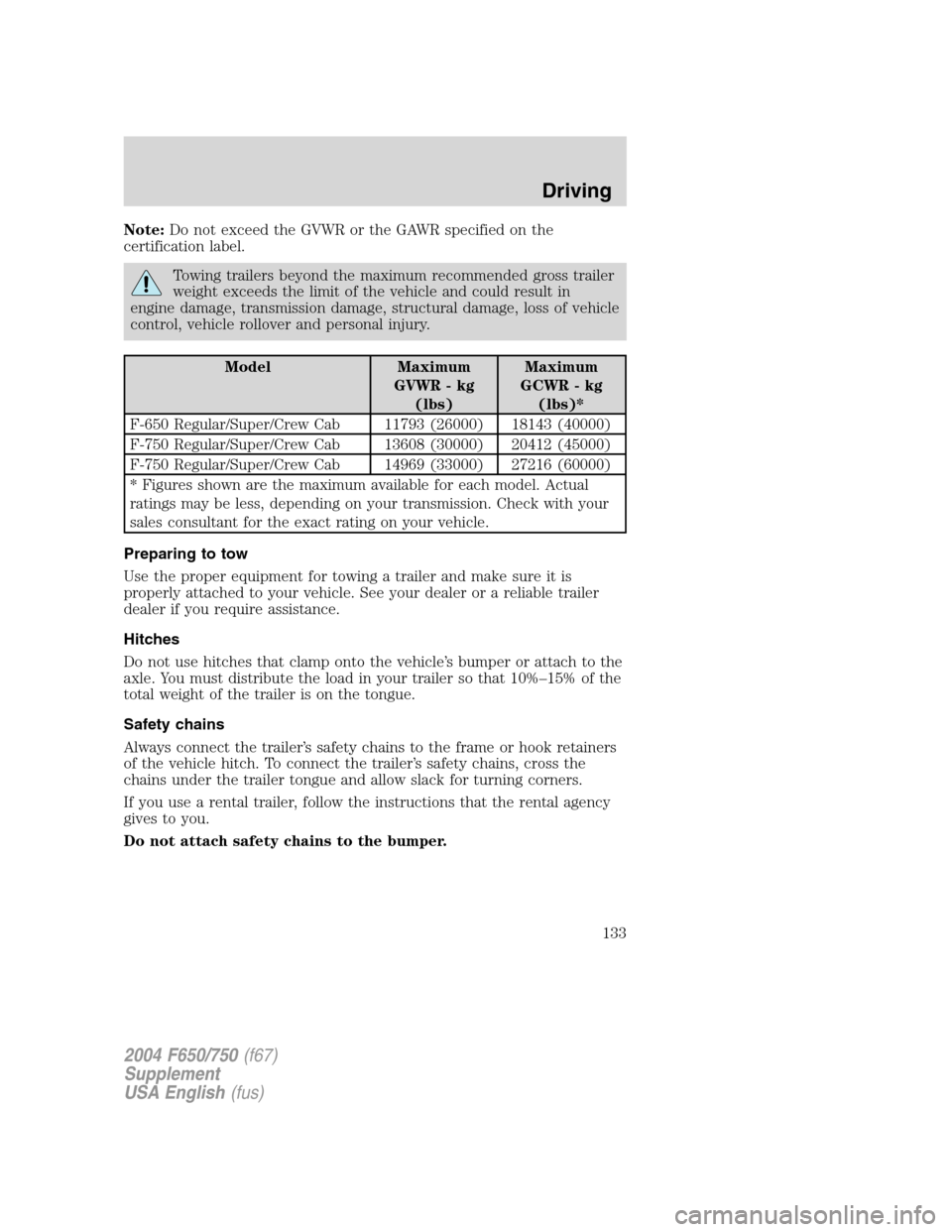
Note:Do not exceed the GVWR or the GAWR specified on the
certification label.
Towing trailers beyond the maximum recommended gross trailer
weight exceeds the limit of the vehicle and could result in
engine damage, transmission damage, structural damage, loss of vehicle
control, vehicle rollover and personal injury.
Model Maximum
GVWR - kg
(lbs)Maximum
GCWR - kg
(lbs)*
F-650 Regular/Super/Crew Cab 11793 (26000) 18143 (40000)
F-750 Regular/Super/Crew Cab 13608 (30000) 20412 (45000)
F-750 Regular/Super/Crew Cab 14969 (33000) 27216 (60000)
* Figures shown are the maximum available for each model. Actual
ratings may be less, depending on your transmission. Check with your
sales consultant for the exact rating on your vehicle.
Preparing to tow
Use the proper equipment for towing a trailer and make sure it is
properly attached to your vehicle. See your dealer or a reliable trailer
dealer if you require assistance.
Hitches
Do not use hitches that clamp onto the vehicle’s bumper or attach to the
axle. You must distribute the load in your trailer so that 10%–15% of the
total weight of the trailer is on the tongue.
Safety chains
Always connect the trailer’s safety chains to the frame or hook retainers
of the vehicle hitch. To connect the trailer’s safety chains, cross the
chains under the trailer tongue and allow slack for turning corners.
If you use a rental trailer, follow the instructions that the rental agency
gives to you.
Do not attach safety chains to the bumper.
2004 F650/750(f67)
Supplement
USA English(fus)
Driving
133